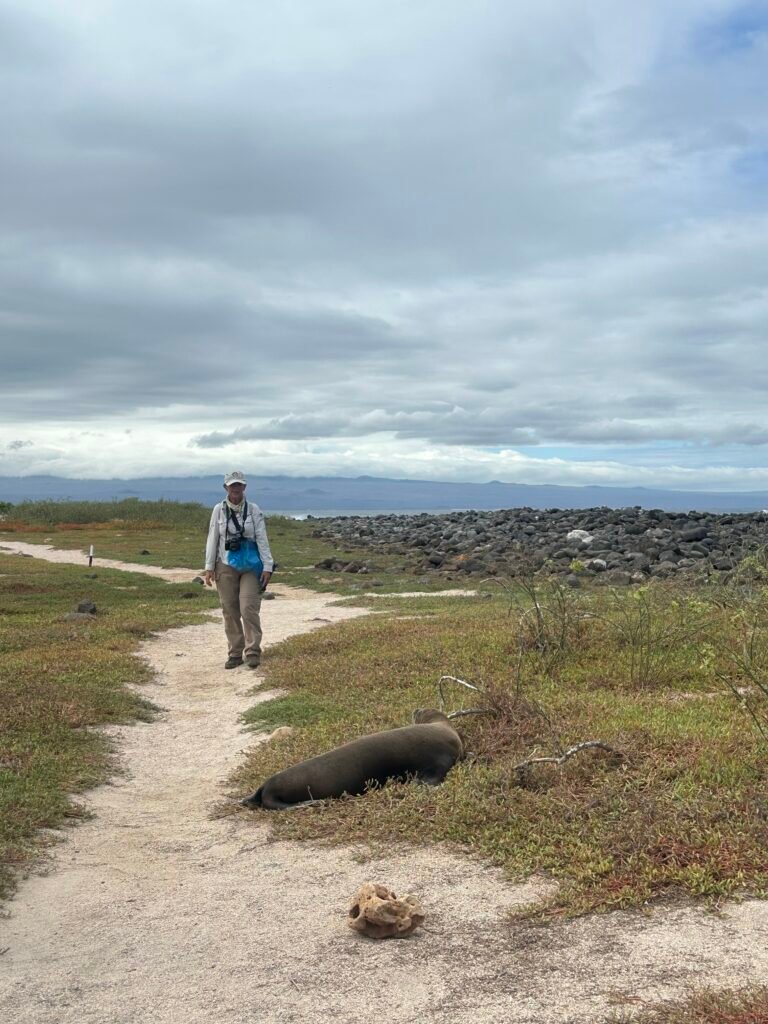
The Floor is Lava (and other reasons to watch your step)
Footwear might just be the most important component of the perfect pack for the Galapagos. Along with headwear (which we’ll get to), good footwear is critical for the islands.
There are wet landings and dry landings, and as we’ve discovered, a lot of varied levels of moist landings in between. Different shoes are required for each.
We have also been on a wide variety of walks. Walks on sand, walks on gravel, walks on corral, walks on rickety wooden stairs, and, walks on Lava. Each comes with its own warning label (or should!)
Walks on Lava
Walking on Lava is one of the many challenges we’ve faced on this trip – in spite of our perfect footwear. The island of Bartholemere / Sullivan Bay is covered with centuries old lava that has spewed and dried. It’s very cool looking (although clearly, it used to be very hot!😆) Nothing lives here with the exception of Lava lizards and Painted locusts. The area is so full of minerality that a compass won’t work here. And if you were lost, you wouldn’t last long anyways — the black floor and bright sky make for a virtual tanning bed. We roasted.
The sun was a hazard on this barren island, and the ground wasn’t so friendly either. Near the dock, there were small puddles of water on the lava, which made it like walking on wet ice or glass. And even in the dry areas, the uneven terrain, and dry bits that sometimes broke off under your feet made it difficult to keep solid footing. Which might have been a good reason to walk slowly and carefully. Instead, I hopped from lava mound to angled peak, and fell. Hard. I’ll spare you the image of my scrapped knee. Instead, please enjoy these beautiful shots of the island and the landscape that I will remember as long as the scar remains on my knee (likely, forever).




More reasons to watch your step: Wildlife
This may be the most obvious reason to watch your step in the Galapagos. The islands are ALIVE. Whether you’re on a boardwalk, a trail, heading out to dinner, or strolling along the beach, looking down is as important as looking up.
The rule here is not to touch the animals, and to stay 2 meters away from them. It’s great in theory, but can be tough in practice – even when the humans follow the rules, the animals don’t seem to.




In search of stable ground.
The Galápagos Islands continue to actively evolve. The volcanoes erupt. The animals migrate and interbreed. The waters warm and cool creating new feeding and breeding impacts. The planet feels more alive (and healthy!) here than anywhere I’ve been. Which also means that the ground is always shifting.
Los Gemelos was a pretty stop on the way to see the giant tortoises on Santa Cruz. These twin sinkholes were hard to capture in photos, but suffice to say, the ground was missing. Truly, there’s no shortage of reasons to watch your step and proceed with caution on these stunning islands.



And one thing you don’t need to watch out for?
Outside of the natural hazards that we’ve learned to look out for here, we have also seen a lot of signage. Don’t walk. Tortoise crossing. Caution. And so many more. We heeded them all (or at least tried to!)
But the sign we saw most was also the most ignored. Stop signs signs were placed like they are at home (eg. in traffic), but clearly, don’t have the same impact. We never saw anyone heed them – they were barely even a suggestion.

In short: animals and pedestrians do their best to live in harmony and maintain this delicate ecosystem. Cars and drivers are a menace to both.





